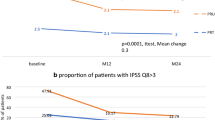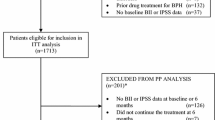Abstract
Purpose
This study evaluated the factors affecting lower urinary tract symptom (LUTS)-related quality-of-life (Qol) scores and the change in the Qol scores following treatment.
Methods
This pooled data analysis study collected the international prostate symptom score (IPSS) with Qol score from five studies which evaluated the change in the IPSS after medication for LUTS. Post-treatment IPSS with Qol scores were measured at 3 months after the initiation of medication.
Results
The mean age of 444 men was 62.5 ± 8.5 years. The mean IPSS total and Qol score at baseline were 18.6 ± 6.7 points and 4.0 ± 0.9 points, respectively. Each IPSS item score, except IPSS 3, was found to be an independent factor that had an influence on baseline Qol scores, with IPSS 7 (nocturia) showing the most significant correlation. After 3 months’ medication, IPSS total and Qol score were significantly decreased to 11.7 ± 6.4 (p < 0.001) and 2.9 ± 1.2 points (p < 0.001), respectively. On multivariate analysis, the improvements in IPSS item 2, 4, 5, and 7 scores were found to be independent factors that had an influence on the improvement in Qol scores. The improvement in IPSS 7 had maximum influence on the improvement in Qol score. Among men with a decrease in total IPSS score by 5 or more points but without improvement in nocturia, Qol was not improved in one-third of them.
Conclusions
Storage symptoms had a greater influence on QoL scores than voiding symptoms. The improvement in nocturia after treatment was the most important factor for the improvement in Qol.

Similar content being viewed by others
References
Irwin DE, Milsom I, Hunskaar S, Reilly K, Kopp Z, Herschorn S, Coyne K, Kelleher C, Hampel C, Artibani W, Abrams P (2006) Population-based survey of urinary incontinence, overactive bladder, and other lower urinary tract symptoms in five countries: results of the EPIC study. Eur Urol 50(6):1306–1314. https://doi.org/10.1016/j.eururo.2006.09.019 (discussion 1314-1305)
Coyne KS, Sexton CC, Thompson CL, Milsom I, Irwin D, Kopp ZS, Chapple CR, Kaplan S, Tubaro A, Aiyer LP, Wein AJ (2009) The prevalence of lower urinary tract symptoms (LUTS) in the USA, the UK and Sweden: results from the Epidemiology of LUTS (EpiLUTS) study. BJU Int 104(3):352–360. https://doi.org/10.1111/j.1464-410X.2009.08427.x
Sarma AV, Wei JT (2012) Clinical practice. Benign prostatic hyperplasia and lower urinary tract symptoms. N Engl J Med 367(3):248–257. https://doi.org/10.1056/NEJMcp1106637
Barry MJ, Fowler FJ Jr, O’Leary MP, Bruskewitz RC, Holtgrewe HL, Mebust WK, Cockett AT (2012) The American Urological Association symptom index for benign prostatic hyperplasia. The Measurement Committee of the American Urological Association. J Urol 148(5):1549–1557 (discussion 1564)
Barry MJ (2001) Evaluation of symptoms and quality of life in men with benign prostatic hyperplasia. Urology 58(6 Suppl 1):25–32 (discussion 32)
Yoshimura K, Arai Y, Ichioka K, Terada N, Matsuta Y, Okubo K (2002) Symptom-specific quality of life in patients with benign prostatic hyperplasia. Int J Urol 9(9):485–490
Perrin P, Marionneau N, Cucherat M, Taieb C (2005) Relationship between lower urinary tract symptoms frequency assessed by the IPSS and bothersomeness (SPI) among men older than 50 years old. Eur Urol 48(4):601–607. https://doi.org/10.1016/j.eururo.2005.06.013
Ojewola RW, Oridota ES, Balogun OS, Ogundare EO, Alabi TO (2016) Lower urinary tract symptoms: prevalence, perceptions, and healthcare-seeking behavior amongst Nigerian men. World J Mens Health 34(3):200–208. https://doi.org/10.5534/wjmh.2016.34.3.200
Adegun PT, Adebayo PB, Areo PO (2016) Severity of lower urinary tract symptoms among middle aged and elderly nigerian men: impact on quality of life. Adv Urol 2016:1015796. https://doi.org/10.1155/2016/1015796
McVary KT, Peterson A, Donatucci CF, Baygani S, Henneges C, Clouth J, Wong D, Oelke M (2016) Use of structural equation modeling to demonstrate the differential impact of storage and voiding lower urinary tract symptoms on symptom bother and quality of life during treatment for lower urinary tract symptoms associated with benign prostatic hyperplasia. J Urol 196(3):824–830. https://doi.org/10.1016/j.juro.2016.04.062
Choi WS, Heo NJ, Lee YJ, Son H (2017) Factors that influence lower urinary tract symptom (LUTS)-related quality of life (QoL) in a healthy population. World J Urol. https://doi.org/10.1007/s00345-017-2052-2
Apostolidis A, Kirana PS, Chiu G, Link C, Tsiouprou M, Hatzichristou D (2009) Gender and age differences in the perception of bother and health care seeking for lower urinary tract symptoms: results from the hospitalised and outpatients’ profile and expectations study. Eur Urol 56(6):937–947. https://doi.org/10.1016/j.eururo.2009.07.050
Roe B, Doll H, Wilson K (1999) Help seeking behaviour and health and social services utilisation by people suffering from urinary incontinence. Int J Nurs Stud 36(3):245–253
Kaplan SA, Roehrborn CG, Rovner ES, Carlsson M, Bavendam T, Guan Z (2006) Tolterodine and tamsulosin for treatment of men with lower urinary tract symptoms and overactive bladder: a randomized controlled trial. JAMA 296(19):2319–2328. https://doi.org/10.1001/jama.296.19.2319
Bliwise DL, Rosen RC, Baum N (2014) Impact of nocturia on sleep and quality of life: a brief, selected review for the International Consultation on Incontinence Research Society (ICI-RS) nocturia think tank. Neurourol Urodyn 33(Suppl 1):S15–S18. https://doi.org/10.1002/nau.22585
Andersson F, Anderson P, Holm-Larsen T, Piercy J, Everaert K, Holbrook T (2016) Assessing the impact of nocturia on health-related quality-of-life and utility: results of an observational survey in adults. J Med Econ 19(12):1200–1206. https://doi.org/10.1080/13696998.2016.1211136
Oelke M, Wiese B, Berges R (2014) Nocturia and its impact on health-related quality of life and health care seeking behaviour in German community-dwelling men aged 50 years or older. World J Urol 32(5):1155–1162. https://doi.org/10.1007/s00345-014-1374-6
Miranda Ede P, Gomes CM, Torricelli FC, de Bessa JJ, de Castro JE, Ferreira BR, Scafuri AG, Bruschini H, Srougi M (2014) Nocturia is the lower urinary tract symptom with greatest impact on quality of life of men from a community setting. Int Neurourol J 18(2):86–90. https://doi.org/10.5213/inj.2014.18.2.86
Kok ET, Bohnen AM, Groeneveld FP, Busschbach JJ, Blanker MH, Bosch JL (2005) Changes in disease specific and generic quality of life related to changes in lower urinary tract symptoms: the Krimpen study. J Urol 174(3):1055–1058. https://doi.org/10.1097/01.ju.0000169256.74421.e5
Sarma AV, Jacobsen SJ, Girman CJ, Jacobson DJ, Roberts RO, Rhodes T, Lieber M (2002) Concomitant longitudinal changes in frequency of and bother from lower urinary tract symptoms in community dwelling men. J Urol 168(4 Pt 1):1446–1452. https://doi.org/10.1097/01.ju.0000028220.74089.ba
Masumori N, Tsukamoto T, Rhodes T, Girman CJ (2003) Natural history of lower urinary tract symptoms in men—result of a longitudinal community-based study in Japan. Urology 61(5):956–960
Author information
Authors and Affiliations
Corresponding author
Ethics declarations
Ethical standard
For this type of study, formal consent is not required.
Conflict of interest
The authors declare that they have no conflict of interest.
Electronic supplementary material
Below is the link to the electronic supplementary material.
Rights and permissions
About this article
Cite this article
Choi, W.S., Son, H. The change of IPSS 7 (nocturia) score has the maximum influence on the change of Qol score in patients with lower urinary tract symptoms. World J Urol 37, 719–725 (2019). https://doi.org/10.1007/s00345-018-2410-8
Received:
Accepted:
Published:
Issue Date:
DOI: https://doi.org/10.1007/s00345-018-2410-8




